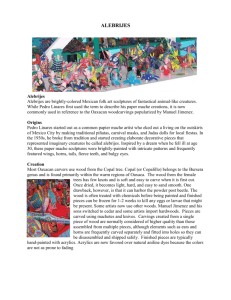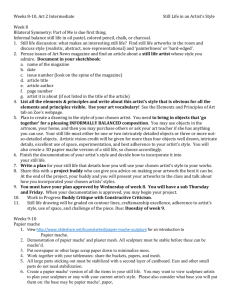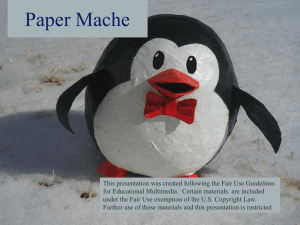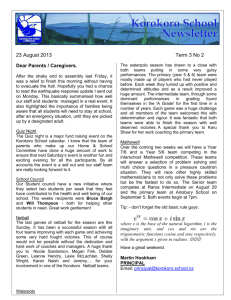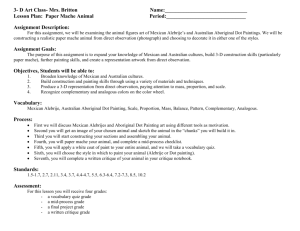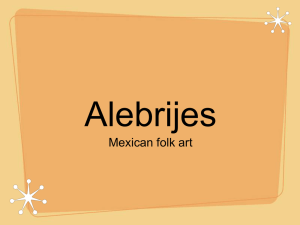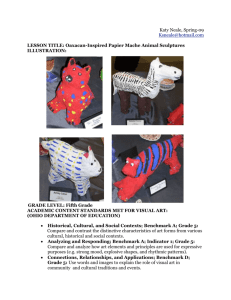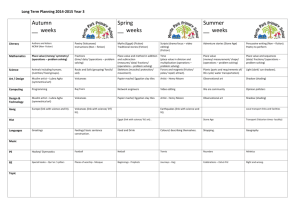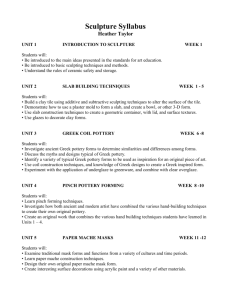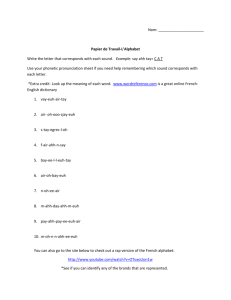File - Illinois Online High School
advertisement
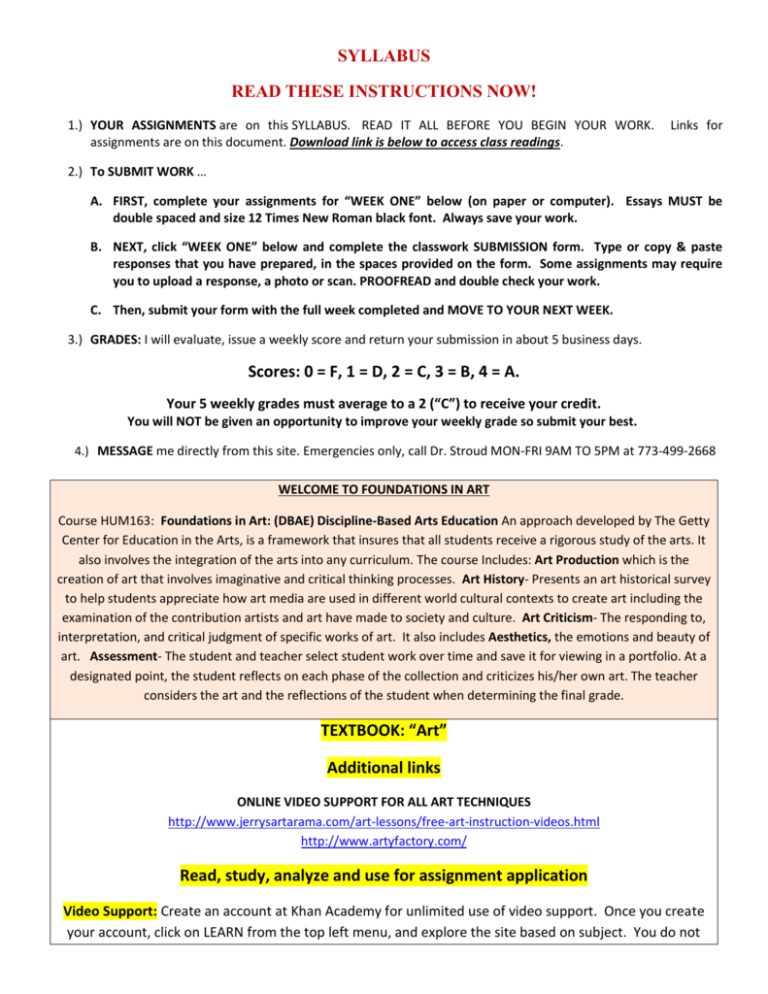
SYLLABUS READ THESE INSTRUCTIONS NOW! 1.) YOUR ASSIGNMENTS are on this SYLLABUS. READ IT ALL BEFORE YOU BEGIN YOUR WORK. assignments are on this document. Download link is below to access class readings. Links for 2.) To SUBMIT WORK … A. FIRST, complete your assignments for “WEEK ONE” below (on paper or computer). Essays MUST be double spaced and size 12 Times New Roman black font. Always save your work. B. NEXT, click “WEEK ONE” below and complete the classwork SUBMISSION form. Type or copy & paste responses that you have prepared, in the spaces provided on the form. Some assignments may require you to upload a response, a photo or scan. PROOFREAD and double check your work. C. Then, submit your form with the full week completed and MOVE TO YOUR NEXT WEEK. 3.) GRADES: I will evaluate, issue a weekly score and return your submission in about 5 business days. Scores: 0 = F, 1 = D, 2 = C, 3 = B, 4 = A. Your 5 weekly grades must average to a 2 (“C”) to receive your credit. You will NOT be given an opportunity to improve your weekly grade so submit your best. 4.) MESSAGE me directly from this site. Emergencies only, call Dr. Stroud MON-FRI 9AM TO 5PM at 773-499-2668 WELCOME TO FOUNDATIONS IN ART Course HUM163: Foundations in Art: (DBAE) Discipline-Based Arts Education An approach developed by The Getty Center for Education in the Arts, is a framework that insures that all students receive a rigorous study of the arts. It also involves the integration of the arts into any curriculum. The course Includes: Art Production which is the creation of art that involves imaginative and critical thinking processes. Art History- Presents an art historical survey to help students appreciate how art media are used in different world cultural contexts to create art including the examination of the contribution artists and art have made to society and culture. Art Criticism- The responding to, interpretation, and critical judgment of specific works of art. It also includes Aesthetics, the emotions and beauty of art. Assessment- The student and teacher select student work over time and save it for viewing in a portfolio. At a designated point, the student reflects on each phase of the collection and criticizes his/her own art. The teacher considers the art and the reflections of the student when determining the final grade. TEXTBOOK: “Art” Additional links ONLINE VIDEO SUPPORT FOR ALL ART TECHNIQUES http://www.jerrysartarama.com/art-lessons/free-art-instruction-videos.html http://www.artyfactory.com/ Read, study, analyze and use for assignment application Video Support: Create an account at Khan Academy for unlimited use of video support. Once you create your account, click on LEARN from the top left menu, and explore the site based on subject. You do not have to create an account to use the site. https://www.khanacademy.org/ Viewing Link and terminology http://www.artcyclopedia.com/ Resource for assignment application Week 1A: COLOR WHEEL HIGH TECH COLOR MIXING: http://www.omsi.edu/tech/colormix.php MEDIUM - Colored pencils and white paper Photograph and upload to a word document COLOR WHEEL VIDEO http://www.5min.com/Video/How-to-Understand-And-Use-The-Art-Color-Wheel-103069948 PROJECT: 12 HUE COLOR WHEEL Make a basic color wheel using 12 hues -- three primary colors and three secondary colors with the six tertiary colors between them and neutral in the center. The colors must be chosen so that they are hues equally spaced around the color circle. The primaries must be cyan, magenta and yellow. It must be clear which colors are primaries, secondaries and tertiaries. The design of the color wheel must have the secondary colors overlapping the primary colors to produce the tertiary colors. Any shapes may be used but it should be clear which colors are primaries, which are secondaries and which are tertiaries. ADD RESPONSE/S/ HERE Week 1B VALUE SCALE Using charcoal or pencil, create this 11 step value scale. Photograph and upload to a word document PROJECT: Make a value scale choosing eleven values that are as evenly spaced as possible. This number gives a ten point scale with black as zero and white as ten. ADD RESPONSE/S/ HERE Week 1C: COLOR PROCESS AND INTERACTION READ TEXT VIDEO LECTURE ON LIGHT AND COLOR http://www.5min.com/Video/How-to-Understand-Color-and-the-Light-Spectrum-78331971 1.) How does the eye process color? 2.) Explain “value” and “saturation”. 3.) What is meant by “color temperature”? Give an example ADD RESPONSE/S/ HERE Week 1D: Article: WHAT IS ART USED FOR? - PDF Summarize the article ADD RESPONSE/S/ HERE Week 2A: EXAMINING ART Locating Examples: ONLINE VIDEO SUPPORT FOR ALL ART TECHNIQUES http://www.jerrysartarama.com/art-lessons/free-art-instruction-videos.html http://www.artyfactory.com/ 1.) locate, copy and place 3 examples of each technique in this document. 2.) Explain briefly why you have selected each as a good example of the specified art technique. 1.) Perspective drawing. In addition, explain how an artist achieves Anamorphosis? 2.) Symmetry – RESPOND: What is required to achieve balance with symmetry? 3.) Lithography – RESPOND: Describe two different techniques. 4.) Abstract Oil Painting - RESPOND: What is meant by “abstract”? 5.) Egyptian Sculpture 6.) Metal and/or Wire Sculpture 7.) Wax Sculpture 8.) Greek Pottery 9.) Collages 10.) Watercolor Painting ADD RESPONSE/S/ HERE Week 2B: PATTERNS STUDY THE LESSONS – USE THE LINK BELOW http://www.artyfactory.com/repeat-patterns/repeat-patterns.html Lesson 1: Repeat Patterns designed from Nature. This lesson teaches you how to design a repeat pattern using any drawing from nature to create a 'tile' unit. This unit is then 'mirrored' like a kaleidoscope to produce a repeat pattern. Lesson 2: Repeat Patterns designed from Your Imagination. The Art of Pattern A repeat pattern composed by mirroring a single tile. Pattern in art is the repetition of lines, shapes, tones, colors, textures and forms. Artists, designers, architects, mathematicians, scientists and engineers have all explored the patterns of nature to discover their decorative elegance and to understand their structural form. A knowledge of how to design repeat patterns is an essential skill for any designer. Today, repeat patterns are seen almost everywhere but they also reach back through the history of design and across all continents and cultures. They are used in tiling, wallpaper, textiles, packaging, backdrops for text or illustrations in graphic media, jewellery and architectural details. They are created using a wide range of media in both two and three dimensions. Most modern pattern design is done on computers for speed and accuracy but historically it was a craftsman-like skill that identified some of the greatest artists and artisans of their day. In December 1881, William Morris, who was one of the greatest pattern designers of the Arts and Crafts Movement, delivered a lecture on 'Some Hints on Pattern Designing' at the Working Men's College in London. He described good decorative pattern as "Something that will not drive us into unrest or callousness; something which reminds us of life beyond itself and which has the impress of imagination strong on it; and something which can be done by a great many people and without too much difficulty and with pleasure." Our lessons on repeat patterns were inspired by the art of William Morris and the Arts and Crafts Movement. ASSIGNMENT Submit 2 drawings of your own design featuring a repeat pattern as learned from each lesson – technique above. Use your lesson link to refresh your skills. ADD RESPONSE/S/ HERE WEEK 3: Papier Mache PAPER MACHE SCULPTURE PROJECT: Create ONE paper mache project. Links are provided to help HOW TO PAPER MACHE: http://video.about.com/familycrafts/Howto-Paper-Mache.htm MAKE A PINATA: http://video.about.com/familycrafts/How-to-Makea-Pinata.htm MAKE A MASK: http://www.howcast.com/videos/180137-How-ToMake-a-PapierMache-Mask 1.) DECIDE which type of paper mache project you will create. 2.) Create your project. Photograph your PAPER MACHE PROJECT from each side and submit it. History of Papier Mache Despite the French sounding name, papier mache was not made in France until the mid 17th century. However, they were the first country in Europe to do so. Papier mache actually originates from China; the inventors of paper itself. They used papier mache to make helmets of all things, which they toughened by many layers of lacquer. Examples have been found dating back to the Han Dynasty (BC 202 – AD 220). From China, the interest in papier mache spread to Japan and Persia, where it was used in mask making and festival activities. Eventually it spread across the world. Large imports of papier mache objects swamped European markets. This in turn led France to start making its own wares, and England followed suit in the 1670s. There was only a half-hearted interest until the late 1700s and into the 1800s, when it became widely used. Papier Mache (French for “chewed paper”) is believed to have got its name from French workers in London papier mache shops who did just that! Whether this is actually true or not we shall probably never know. The manufacturers didn’t seem to mind this idea being put about - possibly because it gave them the chance to hide their true methods and recipes, some of which little is known about even today. In 1740 the manufacturer John Baskerville, well known for his fine quality books and typefounding, began to imitate the lacquered pieces from Japan. This is how the term “japanning” came about. His business was very successful and later his assistant Henry Clay, invented a way to produce papier mache so strong that it was equally as durable as wood. He did this by gluing specially prepared paper under heat to form tough, heat resistant panels. Henry Clay had taken out a patent on his invention, but when this ran out; small companies mushroomed, producing just about everything from papier mache. They were mostly concentrated in the Birmginham and Wolverhampton areas. It is from these companies that we get the beautifully decorated black enameled pieces that are so treasured today. An Englishman – a Northamtonshire Quaker, who was a leading expert in the art of japanning, introduced papier Mache into America. His name was William Allgood and he started up the Litchfield Manufacturing Company. He met with great success in his venture and the company became well known for its fabulously decorated clock cases. Papier Mache lived on in America more as a craft form rather than a manufacturing material. Women started to make useful and decorative household objects. In the 1960’s a bit more papier mache interest was injected by a New York artist called Gemma, who while working with her husband in Mexico managed to stir up a lot of interest amongst Mexican artists who were inspired by her work and later even taught by her. This is despite Mexico’s long history of using papier mache for festivals and traditions, which are still going on today. Papier Mache Recipes Although strictly speaking the correct definition of papier mache is paper fibres and binding agent, there have been some wild and wonderful ingredients used in the past: The binder used was usually glue-water although honey water was sometimes used. Boiling dry animal glue in water until it reached a thick, syrupy stage made glue-water. Luckily for us today, we can go down to the D.I.Y. store and buy a bag of wallpaper paste! Doll heads were extensively made in England and France. They were made in a mould that had a wooden core down the middle. These were made as early as the 16th century in France and by 1810 were in mass production. They are highly collectable today. By 1860 papier mache production had reached its peak. England was still producing a lot of wares, while still importing vast amounts from China. The market became saturated leading to a decline in popularity. Competition from new materials helped the papier mache industry die a death. The final British manufacturer, McCallum and Hodson, closed in 1920. Papier mache is still used today in theatre and stage productions as it makes excellent trees and rocks for scenery being so light and easy to move. Some countries such as Mexico still use papier mache a lot. ADD PHOTOGRAPHS HERE WEEK 4: ART HISTORY http://www.artyfactory.com/art_appreciation/timelines/art_history_timelines.htm Our Western Art Timelines give you information about the artists, movements and styles in Western art from around 1150 to 1880. They offer a brief explanation of the most important styles from Gothic Art to Realism. They also list the major artists and illustrate a key painting from each movement. ASSIGNMENTS 1.) Read the lesson using the link above. Make a chart listing the most important styles discussed, list a summary of the style, and the major artists for each style. Finally include your favorite piece of artwork from that style and tell why you chose it. ADD RESPONSE/S/ HERE Art Movements http://www.artyfactory.com/art_appreciation/art_movements/art_movements.htm Art Movements are the collective titles that are given to artworks which share the same artistic ideals, style, technical approach or timeframe. There is no fixed rule that determines what constitutes an art movement. The artists associated with one movement may adhere to strict guiding principles, whereas those who belong to another may have little in common. Art Movements are simply a historical convenience for grouping together artists of a certain period or style so that they may be understood within a specific context. Art Movements are usually named retrospectively by art critics or historians and their titles are often witty or sarcastic nicknames pulled from a bad review. Grouping artists of similar interests or styles into Art Movements is mainly a characteristic of Western Art. Art Movements are essentially a 20th century development when there was a greater variety of styles than at any other period in the history of art. ASSIGNMENT: Study the lesson using the link above. Discuss each movement below and give the key artists for the movement. Share a sample of art for each movement. Explain the piece and why you chose it as a good representation of the movement. Impressionism Post Impressionism Cubism Fauvism Expressionism Dadaism Pop Art Week 5A: Learning to Critique Art http://www.getty.edu/art/exhibitions/prismatic/watercolor_techniques.html 1.) Read about water color techniques and listen to the discussions on each piece. Now you give a brief critique of each painting. ADD RESPONSE/S/ HERE http://www.getty.edu/art/exhibitions/north_pavilion/cabinet/index.html 2.) Using the link above, explore a handmade mysterious cabinet. Use the mouse to rotate it around and examine each component of each side. Click on “Overview” and read each bit of information. Also click on “show structure” and examine the structure up close. ART SUMMARY: give a summary on this piece along with your artistic critique. Be very detailed and explain clearly ADD RESPONSE/S/ HERE Still Life Techniques http://www.artyfactory.com/still-life/still-life-lessons.html Still Life art lessons are the best way to discover and practice the basic techniques of drawing and painting. You can take the drawing and painting skills that you learn from this lesson and apply them to any subject in art. Each of our still life lessons will teach you about: The fundamental techniques of drawing and painting. The handling of different media. e.g. pencil, chalk pastels and oil pastels. A step by step approach to building up a still life drawing. A step by step approach to building up tone and color. The qualities of a good composition. The practice of still life develops and strengthens your natural level of drawing ability. It improves your observation and rendering of shape, tone, color, pattern and texture in a range of different media. You also learn a lot about composition - the interaction of positive shapes (the objects) and negative space (the area around the objects) ASSIGNMENT 1.) Submit your example of a still life. Discuss your technique and materials used. 2.) Research TWO key still-life artists. Provide a biographical sketch and a critique on 2 art pieces by each artist. ADD RESPONSE/S/ HERE
